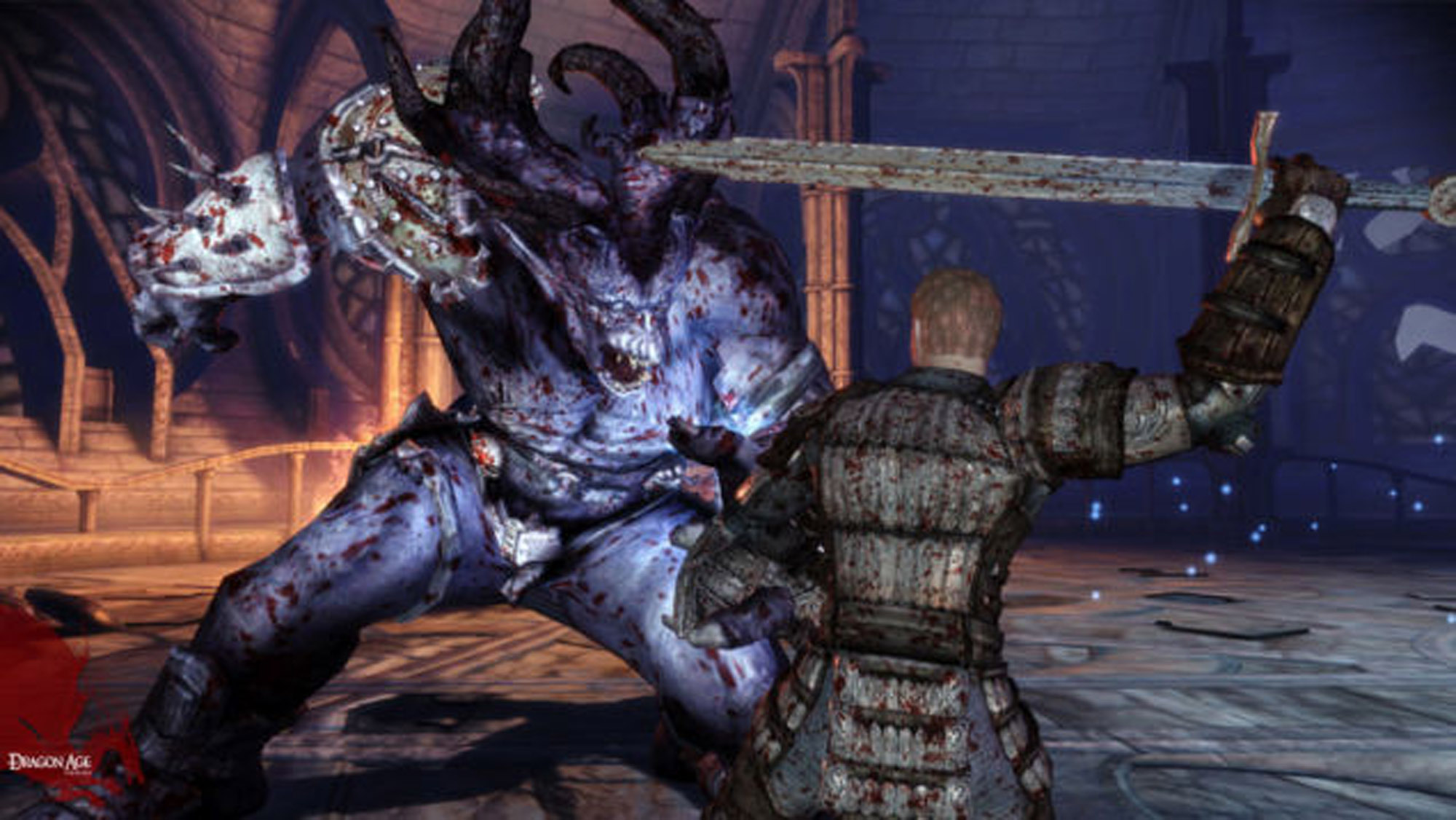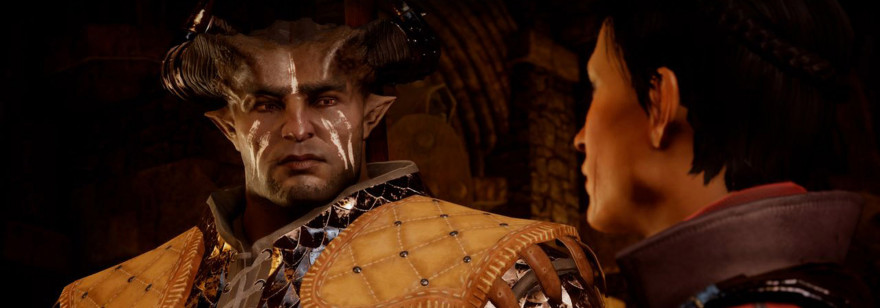This article was written by Elizabeth Sampat and originally published on Gamasutra. You can find more of her writing and games at her website.
It was brought to us by our friends at Critical Distance, who find the best in critical writing about games each week. You can see more at their site, and support them on Patreon.
///
Yesterday I argued with a guy for ten minutes straight about whether or not women had a place in my industry. His big argument was that women are only for cooking and cleaning, so I must secretly be a man. Ooooh, SO ORIGINAL.
This is normally the point at which I would block the guy on Twitter and go about my day, but I can’t. First of all, it’s not Twitter; second, he’s my only 2-hand warrior and I spent a lot of time carefully nurturing his Dexterity and Cunning so he could DPS the shit out of some Darkspawn.
Dragon Age: Origins is a great game, but Sten is kind of an asshole.
Sten is Qunari. That’s a race, a religion, and a complex social structure wrapped up in a “the Borg, but maybe like orcs?” burrito. Qunari see their entire society—the Qun—as a single organism, with each individual assigned a preordained duty to keep the organism healthy and strong. There’s very little of the backstory of how the Qun works in this game, just an awkward and stiff warrior from a backwards culture bound by his code to do horrible things.
But it’s okay! You get to feel cool and superior and progressive by positioning yourself against these backwards things Sten says.
Sigh.
***

It’s an old fantasy—maybe the oldest fantasy mankind has: how can we dream about killing other humans without any guilt? This question lives at the heart of hundreds, maybe thousands, of games. It’s why zombies are so popular right now, and why everyone continues to rehash the same tired ground of WWII: that was the last global conflict everyone generally agrees had clear “right” and “wrong.” (But these games are almost exclusively about killing Nazis, of course—dealing with the Pacific theater means wrestling with the morality of the A-bombs, and who wants that?)
This question definitely exists within other media too, and Tolkien had his own special answer: Orcs.
The orcs were described by Tolkien himself as “slant-eyed” and dark-skinned, with flat noses and brute natures and no form of true civilization. In one of his published letters, he admits they are “in fact degraded and repulsive versions of the (to Europeans) least lovely Mongol-types.”
Written between 1937 and 1945, The Lord Of The Rings was actually the final story in a world Tolkien had been working on since 1917. His work was inevitably influenced by the end of Britain’s “Imperial Century” and the beginning of decolonization, which lead to waves of new immigration.
In fact, the whole idea of the Dwarves, Elves, and Humans banding together against the (literally) dark forces threatening their society mimics the creation of “White” culture in many ways: the idea of “whiteness” is a relatively new construct, something created to band disparate European cultures together against a darker-skinned enemy.
This is the cornerstone of high fantasy, the foundation on which “Tolkienesque” mythology is built: there are some white races, and some dark barbarian hordes that are little better than beasts that serve the forces of darkness, and we all know which is superior. Because Light is good and Darkness is bad.
When we talk about the universal nature of this construct—how good it feels to have lines clearly drawn and the hamfisted but “epic” idea of light versus darkness—we’re talking about universal xenophobia. Sometimes people talk about how the construct of light and dark isn’t about skin— that it goes back to our most basic, most primitive fears of whatever lurked just beyond the firelight.
Which… yes. That’s the root of xenophobia as well.

Since so much of the fantasy genre as it exists today owes debts to Tolkien, much of the fantasy genre is also steeped in backwards and racist tropes, especially when it comes to the “Barbarian” or the “Other.”
You’ll see the same traits pop up anywhere that elves and dwarves are sold: a race that’s violent, possesses far more strength than a human but far less intelligence. Their society is uncivilized and tribal. Most “innovations” in the area of fantasy-racism have been to incorporate more Native tropes to help dilute any African/Asian influence— after all, if your inhuman race of bloodthirsty primitives is an amalgamation of multiple marginalized races, it’s harder to compare it directly to any group of living humans. Which means you’ve got another way to deflect when accusations of racism are made.
But back to the Qunari.
***
The treatment and representation of the Qunari in the Dragon Age universe evolved substantially from that initial run-in with Sten. In Dragon Age II and Dragon Age: Inquisition, you meet two main Qunari characters— the Arishok and Iron Bull. Through them, subtle but important differences between the tropes of the barbarous Other and the Qunari become clear:
- Technological advancement: the Qunari are in possession of gaatlok, an explosive powder that operates without the magical substance lyrium. This makes Qunari more technologically advanced than even Dwarves in an important way.
- Lack of superstition: Qunari are highly educated and well-spoken, able to defend their way of life with logic and reason.
- Willing converts: the Qunari offer a better way of life for many marginalized people from other cultures, and accept them all happily. Though many humans express concerns about forced conversion, it seems that it’s far more common for the Qun to accept willing volunteers.
- Highly structured society based on more than violence: although players are mostly exposed to Qunari warriors because they’re the ones most likely to venture outside of Qunari territory, the entire Qunari society works together as one unit to benefit everyone.
- Progressive values: Instead of the cringe-inducing conversation about gender Sten has with a female Warden, 2 and Inquisition highlight the better angels of Qunari culture. Trans people are welcomed and treated no different from cis people, and it’s strongly implied that Qunari sex culture is generally queer, with little to no regard to gender.
- Kink-positive: When aggressive or violent sex is mentioned in tandem with the barbarous Other, the emphasis is always on rape and dominance—often with the implication that the Other may not truly understand consent or is driven by their animalistic nature. In Dragon Age: Inquisition, this trope is turned on its head through the portrayal of a healthy BDSM relationship dynamic, complete with frank and open communication, safe words, and aftercare.

Ultimately, the thing that sets Qunari culture apart in a discussion of the Other is its nuance. While it is often derided by other characters as a totalitarian regime with no free will, players are given a glimpse into the—for lack of a better term—humanity of the Qunari. Its Otherness is drawn from noble intent taken to extreme, and not animalistic nature given sentience. And, for me, that’s the most important part of worldbuilding anyway— creating a world in which every sentient faction has a perspective and a voice, flaws and achievements.
***
As time goes on and culture progresses, our stories about the Other become more sympathetic: The Borg threat eventually evolved into Seven of Nine gracing the bridge of Voyager, there have been multiple romantic comedies about being in love with zombies, and even the orcs I maligned so thoroughly at the beginning of this article are portrayed somewhat sympathetically in Shadow of Mordor. But will we ever retire the idea of a one-dimensional, alien Other?
The question is why we seek out proxies for xenophobic slaughter in the first place. Ultimately, we fear our own savagery, and dress it up as Other. There’s something in the ignoble parts of humanity that wants to seek a reason to kill another person with impunity— something that grips a sharp rock and tries to see just beyond the firelight.
Is it any wonder joining the Qun sounds so attractive?
///
This article was written by Elizabeth Sampat and originally published on Gamasutra. You can find more of her writing and games at her website.
It was brought to us by our friends at Critical Distance, who find the best in critical writing about games each week. You can see more at their site, and support them on Patreon.
